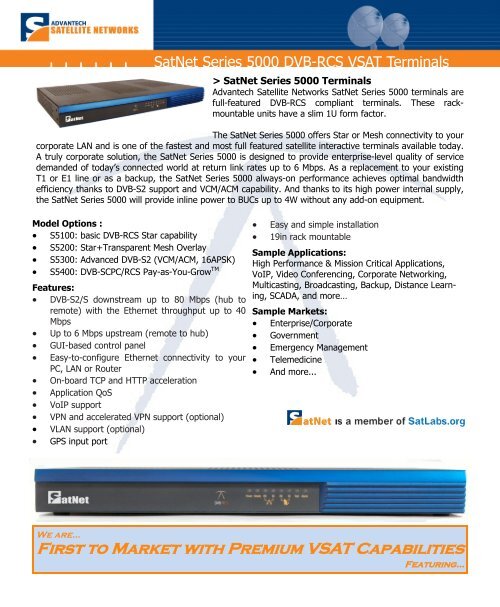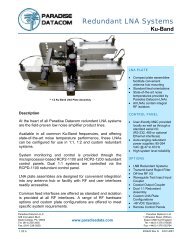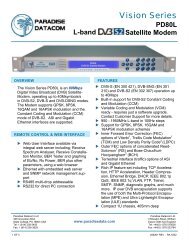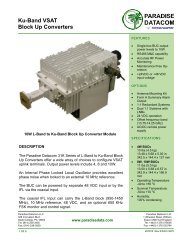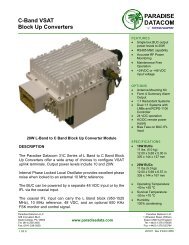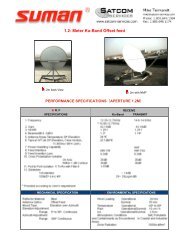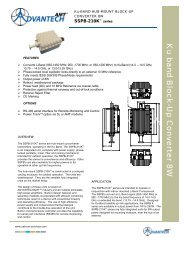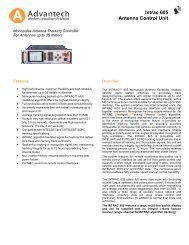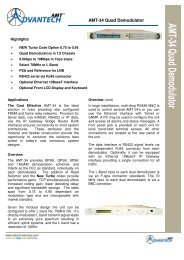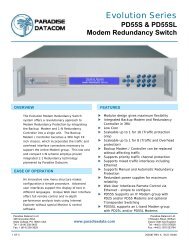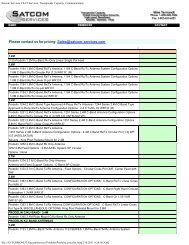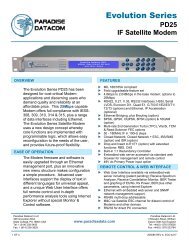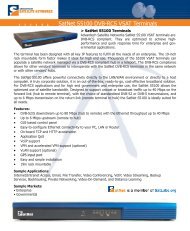5200-S5300 Mesh Terminal and VCM/ACM ... - Satcom Services
5200-S5300 Mesh Terminal and VCM/ACM ... - Satcom Services
5200-S5300 Mesh Terminal and VCM/ACM ... - Satcom Services
Create successful ePaper yourself
Turn your PDF publications into a flip-book with our unique Google optimized e-Paper software.
SatNet Series 5000 DVB-RCS VSAT <strong>Terminal</strong>s<br />
> SatNet Series 5000 <strong>Terminal</strong>s<br />
Advantech Satellite Networks SatNet Series 5000 terminals are<br />
full-featured DVB-RCS compliant terminals. These rackmountable<br />
units have a slim 1U form factor.<br />
The SatNet Series 5000 offers Star or <strong>Mesh</strong> connectivity to your<br />
corporate LAN <strong>and</strong> is one of the fastest <strong>and</strong> most full featured satellite interactive terminals available today.<br />
A truly corporate solution, the SatNet Series 5000 is designed to provide enterprise-level quality of service<br />
dem<strong>and</strong>ed of today’s connected world at return link rates up to 6 Mbps. As a replacement to your existing<br />
T1 or E1 line or as a backup, the SatNet Series 5000 always-on performance achieves optimal b<strong>and</strong>width<br />
efficiency thanks to DVB-S2 support <strong>and</strong> <strong>VCM</strong>/<strong>ACM</strong> capability. And thanks to its high power internal supply,<br />
the SatNet Series 5000 will provide inline power to BUCs up to 4W without any add-on equipment.<br />
Model Options :<br />
• S5100: basic DVB-RCS Star capability<br />
• S<strong>5200</strong>: Star+Transparent <strong>Mesh</strong> Overlay<br />
• <strong>S5300</strong>: Advanced DVB-S2 (<strong>VCM</strong>/<strong>ACM</strong>, 16APSK)<br />
• S5400: DVB-SCPC/RCS Pay-as-You-Grow TM<br />
Features:<br />
• DVB-S2/S downstream up to 80 Mbps (hub to<br />
remote) with the Ethernet throughput up to 40<br />
Mbps<br />
• Up to 6 Mbps upstream (remote to hub)<br />
• GUI-based control panel<br />
• Easy-to-configure Ethernet connectivity to your<br />
PC, LAN or Router<br />
• On-board TCP <strong>and</strong> HTTP acceleration<br />
• Application QoS<br />
• VoIP support<br />
• VPN <strong>and</strong> accelerated VPN support (optional)<br />
• VLAN support (optional)<br />
• GPS input port<br />
• Easy <strong>and</strong> simple installation<br />
• 19in rack mountable<br />
Sample Applications:<br />
High Performance & Mission Critical Applications,<br />
VoIP, Video Conferencing, Corporate Networking,<br />
Multicasting, Broadcasting, Backup, Distance Learning,<br />
SCADA, <strong>and</strong> more…<br />
Sample Markets:<br />
• Enterprise/Corporate<br />
• Government<br />
• Emergency Management<br />
• Telemedicine<br />
• And more...<br />
We are...<br />
First to Market with Premium VSAT Capabilities<br />
Featuring...
<strong>Mesh</strong> Solution<br />
Highlights<br />
• MF-TDMA dual mode star/mesh link: same air interface as for star return link<br />
• Multi-b<strong>and</strong>, multi-beam <strong>and</strong> multi-satellite mesh operation (advanced option)<br />
• Simultaneous star<br />
<strong>and</strong> mesh operation<br />
• Separate IFL for<br />
mesh receiver (for<br />
multi-b<strong>and</strong> <strong>and</strong>/or<br />
opposite polarization<br />
operation)<br />
• <strong>Mesh</strong> signaling in<br />
accordance with<br />
DVB-RCS st<strong>and</strong>ard<br />
• Fully dynamic<br />
mesh capacity assignment<br />
• QoS support for<br />
mesh traffic<br />
The transparent mesh option allows the SatNet S<strong>5200</strong> to be part of a peer-to-peer overlay network, in<br />
which terminals communicate directly with each other through the satellite transponder. This cuts in half<br />
both the transmission delay <strong>and</strong> the b<strong>and</strong>width occupied by such traffic, bringing advantages for both<br />
communications quality <strong>and</strong> cost; the greatest benefits are achieved for delay-sensitive real-time applications<br />
such as voice.<br />
<strong>Mesh</strong>-equipped terminals can communicate simultaneously with other mesh terminals <strong>and</strong> with the hub;<br />
adding the mesh option does not affect the conventional DVB-RCS functionality <strong>and</strong> the mesh functionality<br />
is a fully backwards-compatible extension of the DVB-RCS st<strong>and</strong>ard. Within the mesh overlay part of the<br />
system, the primary functions of the hub are to allocate b<strong>and</strong>width to terminals <strong>and</strong> to control <strong>and</strong> manage<br />
them.<br />
This mesh network functionality is called “transparent”, because it operates through a conventional satellite<br />
transponder. In other words, it does not need any specialized on-board processing. When used in conjunction<br />
with a suitable hub such as the SatNet mesh-enabled hub, the S<strong>5200</strong> terminal supports connectivity<br />
limited only by the space segment design: it supports single-beam configurations, multi-beam configurations<br />
with different cross-strapping constraints <strong>and</strong> even multi-satellite configurations. The mesh <strong>and</strong><br />
conventional “star” operation can be on different polarizations <strong>and</strong>/or in different frequency b<strong>and</strong>s.
Advanced DVB-S2 Solution<br />
The new DVB-S2 st<strong>and</strong>ard offers very significant b<strong>and</strong>width savings in the outbound link of DVB-RCS systems, compared<br />
to the current DVB-S st<strong>and</strong>ard. The simplest form of DVB-S2 is known as Constant Coding <strong>and</strong> Modulation<br />
(CCM). This is a direct replacement for DVB-S, but offers a 30% better b<strong>and</strong>width efficiency, thanks to the use of sophisticated<br />
channel coding techniques. The SatNet terminal supports CCM as well as DVB-S. With the Advanced DVB-<br />
S2 option, the SatNet <strong>S5300</strong> supports two additional, advanced modes of DVB-S2 known as Variable Coding <strong>and</strong><br />
Modulation (<strong>VCM</strong>) <strong>and</strong> Adaptive Coding <strong>and</strong> Modulation (<strong>ACM</strong>). The choice between the latter two is usually driven by<br />
system characteristics such as frequency <strong>and</strong> precipitation statistics. All three forms of DVB-S2 (CCM, <strong>VCM</strong> <strong>and</strong> <strong>ACM</strong>)<br />
have been adopted by the DVB-RCS st<strong>and</strong>ard. DVB-S2 terminals are thus fully interoperable.<br />
<strong>VCM</strong> allows optimization of the transmission parameters used for each terminal,<br />
so that the link budget — <strong>and</strong> hence the achievable b<strong>and</strong>width efficiency<br />
— is no longer driven by the worst case terminal in the system. Differences<br />
that can warrant such optimization include dish size, location in satellite beam<br />
<strong>and</strong> prevailing local rain statistics. Depending on system characteristics, a<br />
<strong>VCM</strong> system can achieve a gain in b<strong>and</strong>width efficiency of close to 50% over<br />
a DVB-S system.<br />
<strong>ACM</strong> takes this optimization further <strong>and</strong> allows variation in time of the modulation<br />
<strong>and</strong> coding used for each terminal. The adjustments are based on feedback<br />
reports of the terminal’s received signal quality. This ability to respond<br />
in real-time eliminates the need for fixed system margins for e.g. rain fade<br />
<strong>and</strong> interference. The margin savings can be converted to increased b<strong>and</strong>width<br />
efficiency. Depending on system characteristics, the gain over CCM<br />
systems can reach 50–100%.<br />
Besides <strong>VCM</strong> <strong>and</strong> <strong>ACM</strong>, the Advanced DVB-S2 option offers additional<br />
valuable features:<br />
• Symbol rates of 128 kBaud – 45 MBaud<br />
• Support for 16APSK modulation, for extremely high b<strong>and</strong>width efficiency<br />
• <strong>ACM</strong> quality feed-back through satellite return link signalling or dial-up telephone line.<br />
Pay-as-You-Grow TM Solution<br />
The Pay-as-You-Grow TM approach enables service introduction with very small initial investment <strong>and</strong> preserves the<br />
investment as the system exp<strong>and</strong>s. Initially, when the number of deployed terminals is very small, the per-user cost of<br />
a full-featured hub that supports dem<strong>and</strong>-assigned management of the return link b<strong>and</strong>width can be significant. In<br />
such small networks, it can be beneficial to defer the cost of the full-featured hub <strong>and</strong> accept temporarily a potentially<br />
less efficient return link b<strong>and</strong>width utilization. In SatNet’s Pay-as-You-Grow TM concept, this is achieved by implementing<br />
the return link as a form of single-channel-per-carrier (SCPC) operation; i.e., using semi-permanent, continuous<br />
connections from each terminal to the hub. When the number of deployed terminals grows, the hub <strong>and</strong> terminals can<br />
be upgraded to fully DVB-RCS compliant, dem<strong>and</strong>-assigned operation.<br />
The forward (outbound) link is shared among the terminals in the same manner in all stages of the Pay-as-You-Grow TM<br />
evolution of the network.<br />
The SatNet S5400 fully supports the Pay-as-You-Grow TM concept. It can be deployed as an SCPC terminal, <strong>and</strong> later<br />
upgraded to full DVB-RCS functionality simply by configuring the software over the air. No hardware modifications or<br />
upgrades are necessary. The change can even be completely transparent to the end user.
SATNET SERIES 5000 VSAT FEATURES & SPECIFICATIONS<br />
Network Architectures<br />
Star, OBP <strong>Mesh</strong>, Transparent <strong>Mesh</strong> (S<strong>5200</strong> model)<br />
Sample <strong>Services</strong><br />
DVB-RCS, TCP/IP, UDP/TCP, Unicast, Multicast, Broadcast<br />
HTTP, SNMP, ICMP, IGMP, DHCP, RIP, RTP, C2P, VLAN (option)<br />
Quality of Service<br />
Multiple Queues, Filtering on IP Header, QoS Groups<br />
Air Interface<br />
Downstream (hub to remote):<br />
- DVB-S (QPSK), DVB-S2 CCM (QPSK & 8PSK), DVB-S2 <strong>VCM</strong>/<strong>ACM</strong> (incl. 16APSK)<br />
(<strong>S5300</strong> model)<br />
- Encapsulation: IP over MPEG with section packing<br />
Upstream (remote to hub):<br />
- DVB-RCS (QPSK), 8PSK<br />
- SCPC (QPSK, 8PSK) (S5400 model)<br />
- Encapsulation: IP over ATM, IP over MPEG with section packing<br />
Coding<br />
RS/Convolutional or LDPC on the downstream; Turbo on the upstream<br />
Data Rates<br />
Can receive the entire DVB-S2 80 Mbps carrier with a maximum Ethernet<br />
throughput of 40 Mbps. Can transmit up to 6 Mbps.<br />
Upstream Burst Rates<br />
64 kbps—6 Mbps in 16 kbps increments<br />
Network Interface<br />
Ethernet 10/100 BaseT, RJ45 connector<br />
ODU Interface<br />
L-B<strong>and</strong> Rx; L-B<strong>and</strong> Tx; F-type connectors<br />
GPS Interface<br />
RS-232 NMEA GPS input port (with Series 5000 IDU)<br />
TCP/HTTP Acceleration<br />
Included<br />
Data Compression<br />
Optional<br />
Security<br />
IPSec option (3DES or AES)<br />
Network Management<br />
SNMP-based <strong>and</strong> GUI-based management, dual software loads, downloadable<br />
software upgrade over the air<br />
BUC Size<br />
Up to 4W (using internal power supply); higher wattage available with optional<br />
external power supply<br />
Supply Voltage<br />
100-240 VAC; 50 Hz/60 Hz<br />
Certifications<br />
CE, FCC, UL, CSA<br />
Outdoor Unit<br />
Variables<br />
Outdoor Units should be dimensioned - Data Rate<br />
for each satellite & application on - Dish size<br />
a case by case basis to satisfy - Tx Power<br />
needs & requirements<br />
- Link Quality & Availability<br />
Frequency Combinations Potential Dimensioning Sets (for Star Network Architectures)<br />
Ka/Ku 128kbps: 75cm/1W<br />
512kbps:<br />
90cm/1W<br />
2.048Mbps:<br />
1.2M/2W<br />
Ku/Ku 128kbps: 90cm/1W<br />
1.024Mbps:<br />
1.2M/2W<br />
2.048Mbps:<br />
1.8M/ 4W<br />
4.096Mbps:<br />
1.8M/ 8W (external supply)<br />
C/C 128kbps: 1.2M/5W<br />
256kbps:<br />
1.8M/5W<br />
512kbps:<br />
1.8M/10W (external power supply)<br />
Advantech Satellite Networks<br />
a division of Advantech AMT<br />
2341 boul. Alfred-Nobel, 4th floor<br />
St-Laurent (Montreal), Quebec, Canada H4S 2A9<br />
Tel.: +1-514-335-3550<br />
Fax: +1-514-335-6386<br />
satnet_info@advantechamt.com<br />
www.advantechamt.com


